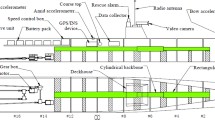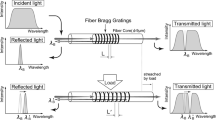Abstract
The use of segmented ship models to test and study various ship responses in model scale poses a challenge to instrumentation and test engineers. In recent years, the authors have developed a segmented ship model to study and trace ice loads acting on the ship hull. The model contains three segments at the bow. Each segment is supported at multiple points which enable the resolution of the location, magnitude, and direction of the external loads. The typical segment support system consists of four vertical, two transverse, and one longitudinal support points with uniaxial compression pression transducers. Stabilization of the segment is achieved by using three specially designed tension links acting in the vertical, transverse and longitudinal directions, respectively. The system is subjected to several levels of calibration which include individual transducer calibration, calibration using internal loading applied by the tension links, external calibration using a specially designed and built calibration rig capable of exerting normal and inclined loads, and calibration of the effects of buoyancy changes in a floating model. The results of calibration and ice-breaking tests indicate that position prediction of the external load can be made within 20 mm. The normal load of less than 100 Newtons can be determined within a few percentage points but the frictional load magnitude and direction are found to be subject to greater errors particularly for low friction factors of the order of 0.1.
Similar content being viewed by others
References
Lewis, E.V., “Ship Model Tests to Determine Bending Moments in Waves,” Trans. soc. of Nav. Arch. and Marine Eng.,62 (1954).
Lewis, E.V. and Dalzell, J.R., “Motions, Bending Moment and Shear Measurements on a Destroyer Model in Waves,” Steven's Inst. of Tech., Rep. 656 (April 1958).
Wachnik, Z.G. and Robinson, D.R., “A Study of Bending Moments in a Ship Model, Moving in Waves,” BS Thesis, Mass. Inst. of Tech. (May 1986).
Dinsenbacker, A.L. and Andrews, J.N., “Vertical and Transverse Loads and Motions of a Segmented Model in Regular Waves,” NSRDC Rep. 3152 (Aug. 1969).
Gerritsma, J. and Beukelman, W., “The Distribution of the Hydrodynamic Forces on a Heaving and Pitching Ship Model in Still Water,” Proc. 11th Symp. on Naval Hydrodynamics, Bergen, Norway, 219 (1964). Also Rep. PUB-124, Tech. Hogeschool, Shipbuilding Lab, Delft, Netherlands (Feb. 1965).
Lloyd, A.R.J.M., Brown, J.C. and Anslow, J.F.W., “Motions and Loads on Ship Models in Regular Oblique Waves,” Trans. of RINA, 21–33 (1979).
Bales, N.K. and Jones, H.D., “Measurement and Reduction of Model-Scale Data on Flare Slamming and Deck Wetness,” paper presented at 19th ATTC, Univ. of Mich. (July, 1980).
Nawwar, A.M., Howard, D. and Bayly, I.M., “Segmented Icebreaking Ship Model Testing-Technique Development,” Proc. IAHR Ice Symp.,III,Hamburg (1984).
Godon, A.M., Nawwar, A.M. and Bayly, I.M., “Segmented Model Technology for Ice Resistance Determination,” Proc. POLAR TECH '88, Trondheim, Norway (June 1988).
Author information
Authors and Affiliations
Additional information
A.M. Nawwar (SEM Member), presently Associate Professor of Mechanical Engineering, Kuwait University, Kuwait 13060
Rights and permissions
About this article
Cite this article
Nawwar, A.M., Godon, A., Roots, T. et al. Development of a measuring system for segmented ship models. Experimental Mechanics 29, 101–108 (1989). https://doi.org/10.1007/BF02321360
Received:
Revised:
Issue Date:
DOI: https://doi.org/10.1007/BF02321360




